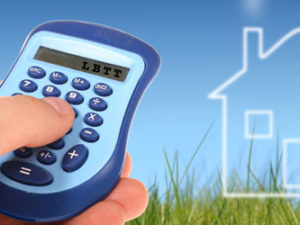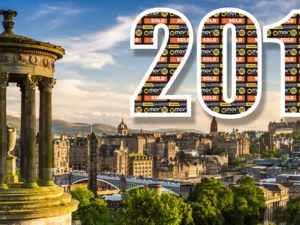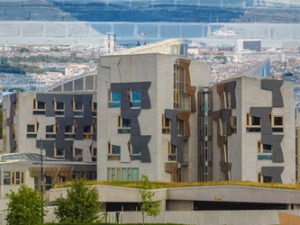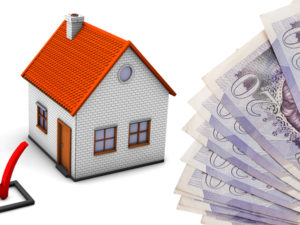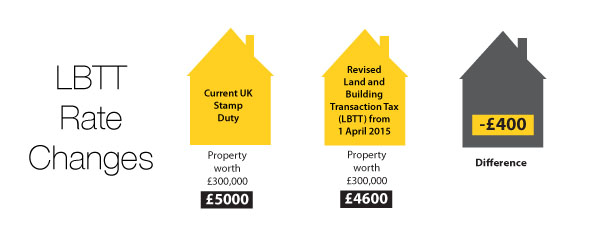
The Scottish Deputy First Minister, John Swinney, announced further changes to the Land and Buildings Transaction Tax (LBTT) system when the 2015-16 budget was debated at Holyrood on 21 January 2015. This will affect the rates of tax payable by property purchasers under LBTT when it replaces Stamp Duty, which itself has had a recent radical overhaul, for property transactions in Scotland that complete on or after 1 April 2015. The changes include amended rates and an increased threshold at the lower level. The new rates will replace those previously announced in October 2014.
The lowest threshold, where LBTT will first apply to property purchases, is now proposed to be £145,000. This means that anyone buying a property up to £145,000 will not be paying any tax, up from the current £125,000 threshold: good news for first time buyers. The thresholds and rates over £250,000 have also been amended, primarily with a reduction in the rate applicable to the £250,000 to £325,000 part of the purchase price, and a reduction in the threshold for the highest rate, from £1m to £750,000.
With the rates payable under Old Stamp Duty, New Stamp Duty, LBTT and now New LBTT having felt more like a game of musical chairs than a well-thought-out tax system for property buyers whose decision-making process will have been changing daily in response to these changes, we have pulled-together the guide below to help you understand the definitive taxation position as well as letting you know what it all means for you as a property buyer or seller in Scotland.
Stamp Duty vs New LBTT Rates Calculator
If you would like to calculate and compare the difference between what New Stamp Duty and New LBTT will cost you without reading our guide, please have a look at our handy Calculator by clicking here: http://www.mov8realestate.com/property-purchase-tax-calculator-for-scotland/
Old Stamp Duty, New Stamp Duty, LBTT, New LBTT…Quick Recap!
Old LBTT to Replace Old Stamp Duty
In short, not too long ago, everyone in the UK paid Stamp Duty ‘or SDLT’ (for this article, ‘Old Stamp Duty’) on property purchases. Towards the end of last year, the Scottish Government firmed-up plans for its own replacement of Stamp Duty, known as Land and Buildings Transaction Tax (LBTT). The rates that were likely to be payable under this system were published. Given that it applied to property purchases with a completion date on or after 1 April 2015, it conceivably would have affected people’s buying or selling decisions immediately. It is also not entirely implausible that, with elections in 2015, political parties have been using the property taxation system as a means of demonstrating their wares to the voting public.
At the higher end of the market, it meant that property buyers would pay significantly more tax, so buyers wanting to benefit from the existing Stamp Duty regime would need to hurry. But overall it meant that 95% of property buyers in Scotland would pay less tax on property purchases than their counterparts south of the border. First strike to the SNP – take that George Osborne!
New Stamp Duty Replaces Old Stamp Duty
At the beginning of December 2014, the UK government announced an overhaul of Stamp Duty (for our purposes, ‘New Stamp Duty’). It would affect the whole of the UK, but it would only affect Scotland until 1 April 2015 when LBTT took-over from this New Stamp Duty.
The net result was that, whereas some property buyers in Scotland would have been better-off waiting until 1 April 2015 for LBTT to apply to their purchase, they would suddenly stand to save money by buying and completing before 1 April 2015. For most property buyers, New Stamp Duty was more attractive than Old Stamp Duty. And, crucially, although New Stamp Duty was either neutral or a wee bit less attractive than LBTT for the vast majority buyers in Scotland, it was very, very significantly more attractive than LBTT for many property buyers at the ‘higher end’ of the market. The UK Conservative party strikes back – take that SNP! And so it continues now with New LBTT…
New LBTT to Replace Not-Yet-Launched Old LBTT
In response to the UK Government overhaul of Stamp Duty, and in the face of opposition party calls to bring LBTT in line with New Stamp Duty, the Scottish Government announced an overhaul of the proposed LBTT rates that would be effective in Scotland from 1 April 2015 onwards.
These replace the previously-published rates. They also change the thresholds where these amounts are payable. The net effect is that, compared to the previously-published LBTT rates, more people are better-off. However, compared to existing, New Stamp Duty rates, buyers at the higher end of the market are still definitely better-off under the UK regime of New Stamp Duty and there is likely to be a (no pun intended) stampede of buyers trying to get their purchase transaction done and dusted before 1 April 2015.
The New LBTT Rates in More Detail
If we compare what the Scottish Government proposed back in October versus what was announced on 21 January 2015, everyone buying a property with a value up to £948,000 is better-off.
The rates and thresholds announced on 21 January, although still described as ‘proposed’ rates, are as follows:
| Up to £145,000: | No tax (threshold increased from £135,000) |
| £145,000 – £250,000: | 2% (% of the bit between £145,000 and £250,000) |
| £250,000 – £325,000: | 5% (% of the bit between £250,000 and £325,000) |
| £325,000 – £750,000: | 10% (% of the bit between £325,000 and £750,000) |
| Above £750,000: | 12% (% of the bit above £750,000) |
The previously-announced rates and thresholds were:
| Up to £135,000: | No tax |
| £135,000 to £250,000: | 2% (% of the bit between £145,000 and £250,000) |
| £250,000 – £325,000: | 5% (% of the bit between £250,000 and £325,000) |
| £325,000 – £750,000: | 10% (% of the bit between £325,000 and £750,000) |
| Above £750,000: | 12% (% of the bit above £750,000) |
How Will This Affect the Cost of Your Property Purchase?
With the UK-wide change in Stamp Duty from 3 December 2014, the crucial aspect for Scottish buyers is how their tax liability will change between ‘New Stamp Duty’ (applicable for purchases completing/settling between 3 Dec 2014 and 1 April 2015) and New LBTT, which comes into force for purchases completing on or after 1 April 2015. The following illustrates the difference in tax for a representative sample of property purchase prices:
| Purchase Price | New Stamp Duty | LBTT (new rates) | Difference |
|---|---|---|---|
| £250,000 | £2,500 | £2,100 | -£400 |
| £275,000 | £3,750 | £3,350 | -£400 |
| £300,000 | £5,000 | £4,600 | -£400 |
| £325,000 | £6,250 | £5,850 | -£400 |
| £350,000 | £7,500 | £8,350 | +£850 |
| £400,000 | £10,000 | £13,350 | +£3,350 |
| £500,000 | £15,000 | £23,350 | +£8,350 |
| £700,000 | £25,000 | £43,350 | +£18,350 |
| £800,000 | £30,000 | £54,350 | +£24,350 |
| £1m | £43,750 | £78,350 | +£34,600 |
How to Ensure a Smooth Purchase or Sale
As mentioned above, the rates and thresholds announced are still proposed rates. With less than 12 weeks to go before LBTT goes ‘live’, there should be a further announcement from the Scottish Government, before 1 April 2015, to confirm the rates and thresholds which will apply after that date.
On and around 30 March 2015, Scottish conveyancing solicitors will be having palpitations. The chance of a last-minute snag is high at the moment, particularly given the recent once-in-a-generation changes that have been made to the entire conveyancing system in Scotland – http://www.mov8realestate.com/2014/12/land-registration-etc-scotland-act-2012-mean-property-buyers-sellers-scotland/. This could have the effect of the settlement being delayed from slightly before to slightly after the 1 April 2015 change-over date from Stamp Duty to LBTT.
Buyers who wish to complete their purchase before 1 April 2015 should do everything in their power to have absolutely everything in order at their end. That includes having all mortgage and finance paperwork, including proof of source of funds, absolutely to hand and sent over to solicitors in record time.
One of the main reasons that purchases are delayed is delays in lenders providing the purchasing solicitor with paperwork regarding the mortgage. A professional, independent mortgage adviser can assist hugely with this process and speed it up, and anyone thinking of settling around this time to save a significant amount of tax would do well to speak to a professional mortgage adviser rather than trying to shop-around themselves for their mortgage.
For the seller, the chance of the sale falling-through if the buyer can’t secure a settlement date that’s suitable is also significant. Sellers should therefore read all paperwork sent to them by their solicitors, very carefully, and make sure that all paperwork or issues that could hold-up the sale, such as permissions and completion certificates for alterations, confirmation of the estate or inhibitions due to unpaid Council Tax are provided to the solicitor as early in the process as possible.
Stamp Duty and LBTT Calculator
Meantime, if you would like to calculate the difference between what New Stamp Duty and New LBTT will cost you, please have a look at our handy Calculator by clicking here: http://www.mov8realestate.com/property-purchase-tax-calculator-for-scotland/
We’ll keep you posted as and when we hear the news, but if you’d like to discuss how this may affect your sale or purchase in the meantime, please don’t hesitate to drop us an e-mail, or give our Negotiation Team a call for advice!



